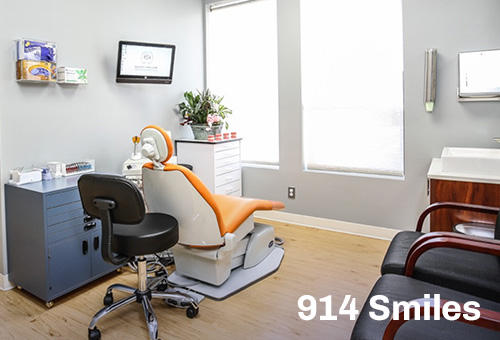
The temporomandibular joints (TMJ) are located on either side of your face and connect your jaw to the temporal bones of the skull. The joints allow your jaw to open and close and move side to side to do things like chew, speak, laugh and yawn.
The TMJ is a complex joint and part of your larger chewing system, along with your nerves, muscles, teeth and jawbone. That’s why when you experience a temporomandibular joint disorder (TMJD), sometimes also called a temporomandibular disorder (TMD), it can cause significant pain and dysfunction.
Symptoms of TMJD include TMJ and jaw pain, tenderness, headaches, ear pain, difficulty opening and closing your mouth, locking of the jaw, clicking or popping noises and stiffness.
As an expert in the biomechanics of the chewing system, orthodontist Dr. Rishi Kothari diagnoses and treats TMJD in Tarrytown at our practice. He always recommends trying conservative, non-invasive methods before opting for more permanent solutions like surgery. One of the first steps is often homecare, which can include TMJ exercises to relieve discomfort and improve mobility.
Important Note
It’s crucial that you ease into doing TMJ exercises and start slowly. If the exercises hurt, stop doing them, and try other home remedies to get the pain and inflammation under control before trying again.
If the exercises still hurt after resting your jaw, they cause the pain or other symptoms to get worse or you don’t have any relief within a week, discontinue the exercises and reach out to an oral health professional like Dr. Kothari.
TMJ Pain Relief
Exercises
Studies have found that jaw exercises for TMJ pain are effective at alleviating discomfort and stiffness. In fact, one study discovered therapeutic exercises worked more quickly than TMJ splints for people whose dysfunction was related to a displaced disc.
Here are 5 TMJ stretches and strengthening moves to try:
Tongue Up
Place your tongue against the roof of your mouth with the tip just behind your front teeth. Keeping your tongue in place, open your mouth slightly so your lips and teeth are parted. Relax your jaw. Take six deep breaths, making sure your stomach expands on the inhale and contracts on the exhale. Repeat this three times.
Open and Close
One of the best TMJ stretches is to keep your lips and teeth slightly apart and relax your jaw. Then, slowly open your mouth as wide as you can while you look up with your eyes (don’t move your head or neck as you do this). Hold your mouth open for several seconds and then close it slowly. Repeat this five times.
Side to Side
Another way to stretch your TMJ and jaw is to close your mouth and, without moving your head or neck, move your jaw to the left side while also looking left with your eyes. Hold this for a few seconds before returning to center. Repeat on the right side. Do this five times.
Tongue Up Variation
Just like in the first TMJ exercise, place your tongue against the roof of your mouth. Without letting your tongue drop, slowly open your jaw as far as you can. Hold it for six seconds and then, still without moving your tongue, slowly close your jaws. Do this again, but instead of closing your mouth, gently move your jaw from side to side. Repeat these five times.
Tongue Up With Resistance
TMJ exercises with an element of resistance can strengthen the chewing muscles and joints. If you made it through the stretches and you’re not in pain, again, place your tongue against the roof of your mouth. Now, place your thumbs or forefingers right under your chin. Without dropping your tongue, slowly open your mouth against the resistance. Hold it open for six seconds and then slowly close it. Try doing this 10 times.
These basic TMJ pain relief exercises are a good start. As you regain mobility and your pain improves, you may also want to add some other tried-and-true TMJ exercises to your regimen, such as:
- Rocabado 6×6 TMJ Exercise Routine
- Kraus’ Temporomandibular Joint Exercises
- Oxford University Hospitals’ Exercises to Improve Jaw Function
Additional TMJ Home Remedies
When it comes to how to help TMJ pain, you may need a combination of exercises and other homecare. Effective TMJ home remedies include:
- Resting your joints by keeping your jaw relaxed and in its resting position as often as possible. Minimize wide jaw movements by avoiding:
- Large yawns
- Yelling
- Eating crunchy, hard foods or foods that require a lot of chewing
- Taking big bites of food
- Chewing gum
- Biting your nails
- Sticking with a soft foods diet until your pain subsides.
- Practicing good posture. Mayo Clinic has a helpful illustration of what good posture looks like.
- Taking an over-the-counter, non-steroidal, anti-inflammatory medication (NSAID) as needed, if appropriate.
- Using hot or cold compresses. For acute pain and swelling, hold a cold compress against your jaw for 15 minutes on and 15 minutes off. After a day or two, switch to hot compresses, which will help relax your jaw and increase blood flow. Use the warm compress for 15 minutes on and off as well.
- Reducing stress to loosen and relax your jaw. Practice yoga, go for a jog, do deep breathing or make time for a favorite hobby.
Connect With a Tarrytown Orthodontist About Your TMJ Pain
These TMJ exercises and home remedies can be extremely helpful for managing pain and stiffness. However, if you’ve been experiencing TMJD symptoms, it’s still important to have the underlying cause diagnosed. Dr. Kothari can help.
Schedule a visit at 914 Smiles. Dr. Kothari will perform an exam, take diagnostic records and chat with you about your symptoms in order to develop an accurate diagnosis and personalized treatment plan.



